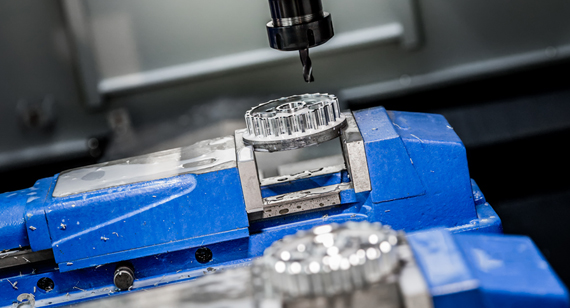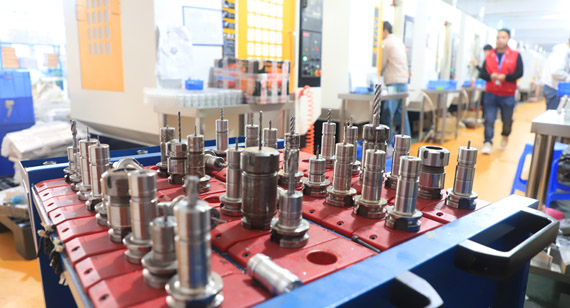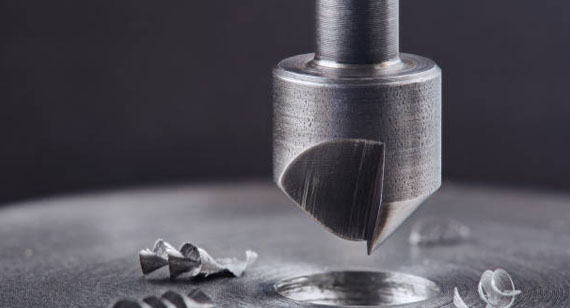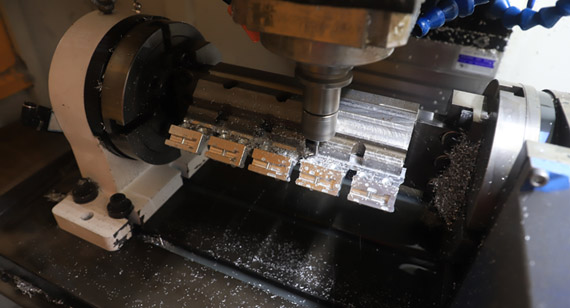15 years one-stop China custom CNC machining parts factory
 364 |
Published by VMT at Oct 20 2024
364 |
Published by VMT at Oct 20 2024
End milling is a critical process in CNC machining that allows for high-precision cutting and shaping of various materials. With its ability to perform intricate designs and complex geometries, end milling has become an essential operation in the manufacturing sector, especially in industries that require custom CNC machined parts. This article delves into the different types of end mills, their applications, advantages, and processes involved in end milling.
End milling is a machining process that utilizes rotating cutting tools known as end mills to remove material from a workpiece. Unlike traditional milling, which typically involves a flat surface cutter, end milling can access both the end and the sides of the tool, enabling the creation of deep and intricate features. The process is characterized by its versatility and precision, allowing for the production of complex shapes and contours that are vital in custom machining applications.
End mills can produce various features such as grooves, slots, and profiles, making them suitable for a wide range of materials, including metals, plastics, and composites. The operation can be performed on different types of CNC milling machines, which vary in size, capacity, and complexity. The choice of end mill and milling parameters significantly influences the quality and efficiency of the machining process.

End milling machines come with several features that enhance their performance and capabilities. These include:
Versatile Tooling: End milling machines can accommodate a variety of end mills, allowing for different operations and material types. The adaptability of the machines makes them suitable for various applications, from simple cuts to complex 3D shapes.
Precision Control: CNC end milling machines offer high precision, ensuring that parts are manufactured within tight tolerances. The use of advanced software allows for precise control over cutting speeds, feed rates, and tool paths, contributing to better surface finishes and dimensional accuracy.
Automated Features: Many modern end milling machines incorporate automation features, such as tool changers and automated workpiece loading systems. These features increase efficiency by minimizing downtime and reducing the need for manual intervention.
Rigidity and Stability: A robust construction of the machine bed and spindle ensures stability during operation, reducing vibrations that can affect the quality of the machined part.
Ease of Maintenance: End milling machines are designed with accessibility in mind, allowing operators to perform routine maintenance easily. This enhances the longevity of the equipment and minimizes the risk of breakdowns.
The features of end milling machines make them a cornerstone of CNC machining, enabling manufacturers to produce high-quality parts efficiently.
The cost associated with end milling can vary significantly based on several factors, including the type of end mill, the material being machined, and the complexity of the machining process. While initial investments in CNC milling machines and tooling can be high, the overall cost-effectiveness of end milling becomes evident when considering its precision and efficiency.
Tooling Costs: End mills are available in various materials and coatings, each with a different price point. High-speed steel (HSS) end mills are generally more affordable, while carbide and cobalt options offer higher performance but at a greater cost. The selection of the appropriate tool is crucial for balancing performance and budget.
Material Costs: The type of material being machined also influences costs. Softer materials like plastics are easier to cut and can lower tool wear, while harder metals may require more expensive tools and slower feed rates, impacting overall expenses.
Operational Costs: The efficiency of the machining process plays a significant role in the total cost. End milling allows for high feed rates and rapid removal of material, which can reduce machining time and costs. Additionally, effective coolant and chip removal systems can enhance tool life and performance, minimizing downtime and wastage.
Setup and Labor Costs: End milling operations may require a higher skill level from machinists, influencing labor costs. However, the precision achieved through end milling often reduces the need for secondary operations, balancing out initial labor investments.
In summary, while the costs associated with end milling can vary, the benefits of precision, versatility, and efficiency often outweigh the initial expenditures, making it a valuable investment for manufacturers.
End milling and traditional milling share similarities, but they also have distinct differences that affect their applications and outcomes. Understanding these differences is crucial for manufacturers when selecting the right machining process for their needs.
Cutting Tools: Traditional milling primarily utilizes flat end mills or slab mills that can only cut along the face of the tool. In contrast, end mills feature cutting edges on both the end and the sides, allowing for more versatile operations, including slotting, contouring, and pocketing.
Capabilities: End milling is particularly advantageous for creating intricate features and profiles due to its ability to engage with the workpiece from multiple angles. Traditional milling is generally more limited in its capabilities, often reserved for basic flat surfaces and simple cuts.
Machining Process: The approach to machining differs between the two. End milling allows for both peripheral and face cutting, making it suitable for various operations in custom CNC machining. Traditional milling focuses primarily on face cutting, which limits its versatility.
Surface Finish and Tolerances: End milling typically achieves better surface finishes and tighter tolerances compared to traditional milling. This precision is critical for industries requiring high-quality machined parts, such as aerospace and automotive.
Operational Efficiency: End milling machines often operate at higher speeds and feed rates, contributing to increased efficiency and reduced cycle times. Traditional milling may involve slower operations and longer production times.
In conclusion, while both end milling and traditional milling are essential processes in machining, end milling offers enhanced capabilities, precision, and versatility, making it the preferred choice for complex and high-quality machining applications.
End milling works by utilizing rotary cutting tools that remove material from the workpiece through a combination of rotational and linear motions. The process involves several key steps:
Tool Selection: The first step in end milling is selecting the appropriate end mill based on the material to be machined, the desired geometry, and the required tolerances. Different types of end mills, such as roughing, finishing, and specialized end mills, cater to specific applications.
Setup: Proper setup is crucial for effective end milling. This involves securely clamping the workpiece in place, ensuring it is aligned correctly, and adjusting the machine settings, including cutting speed and feed rate. Ensuring stability during machining minimizes vibrations that could affect the quality of the finished part.
Machining Operation: Once the setup is complete, the end mill is engaged with the workpiece. The rotational motion of the end mill, combined with the linear movement of the CNC machine, allows for precise cutting. The cutting edges of the end mill remove material as it passes through the workpiece, producing the desired shape or feature.
Chip Removal and Cooling: During the end milling process, chips are generated as material is removed. Effective chip removal is essential to prevent clogging and ensure smooth operation. Additionally, coolant may be applied to reduce heat, lubricate the cutting area, and enhance tool life.
Quality Control: After machining, the finished part is inspected for quality, ensuring it meets the specified tolerances and surface finish requirements. Any necessary adjustments to the process can be made based on the results of the inspection.
In summary, end milling is a sophisticated machining process that combines precise tooling, careful setup, and effective operational techniques to produce high-quality machined parts efficiently.
End mills are versatile tools suitable for a wide range of operations in CNC machining. Understanding when to use an end mill is crucial for optimizing the machining process and achieving the desired results. The following are typical operations that require end milling:
Grooving
End mills are frequently used for grooving operations, which involve creating narrow cuts or channels in a workpiece. This operation is essential for preparing parts for assembly or providing space for features like O-rings or seals.
Contouring
Contouring is the process of shaping the workpiece to follow a specific profile. End mills can navigate complex contours due to their ability to cut on both the end and sides, making them ideal for creating intricate shapes in custom CNC machined parts.
Inserting
When inserting features into a part, such as pockets or slots for connectors, end mills provide the precision needed to achieve tight tolerances. Their capability to cut through various materials makes them suitable for insertion operations in multiple industries.
Profiling
Profiling involves machining a workpiece to achieve a specific outline or profile. End mills excel in profiling due to their diverse shapes and sizes, allowing for various design requirements to be met efficiently.
Conventional Roughing
End mills are ideal for roughing operations where material removal is the primary goal. Using roughing end mills enables quick material removal while maintaining tool life and minimizing vibrations.
Profiling and More
In addition to these typical operations, end mills can also perform tasks such as drilling, reaming, and more, making them an essential tool in a CNC machining factory.
Understanding the appropriate applications for end mills enhances manufacturing efficiency, enabling engineers and machinists to produce parts that meet high standards of quality and precision.
End mills are utilized across a broad spectrum of industries due to their versatility and precision. Some of the key sectors that rely on end milling include:
Aerospace: In aerospace manufacturing, end mills are crucial for producing lightweight components that require high precision and complex geometries. The stringent tolerances and quality standards in this industry necessitate the use of advanced end milling techniques.
Automotive: The automotive sector frequently employs end milling for creating parts such as engine components, transmission housings, and chassis elements. The ability to machine diverse materials, including aluminum and composites, makes end mills indispensable in automotive production.
Medical Devices: End milling is essential in the medical device industry for fabricating components like surgical instruments, implants, and diagnostic equipment. Precision is critical in this field, and end mills deliver the necessary accuracy and surface finish.
Electronics: In the electronics sector, end mills are used for machining housings, circuit boards, and connectors. The ability to create intricate designs and fine features is vital for meeting the demands of modern electronic devices.
Mold and Die Making: End mills play a significant role in mold and die making, where precise shapes and dimensions are crucial. The ability to machine complex features with high precision makes end milling an ideal choice for this industry.
General Manufacturing: Various manufacturing operations, from custom CNC machining to prototyping, benefit from the versatility of end mills. Their adaptability allows for a wide range of applications, contributing to the efficiency of the manufacturing process.
In conclusion, end mills are vital in multiple industries, enabling manufacturers to produce high-quality components efficiently. Their versatility and precision make them indispensable tools in modern machining operations.
End mills can be categorized based on various factors, including shape, number of flutes, and material composition. Understanding these categories is essential for selecting the right end mill for specific applications.

Types of End Mills: By Shape
Roughing End Mills: Designed for rapid material removal, roughing end mills have fewer flutes and larger cutting edges, making them ideal for aggressive cuts.
V-Drills: These end mills feature a V-shaped cutting tip, allowing for precise drilling and machining of small holes and details.
Square Head Mills: Square head mills have flat cutting edges, making them suitable for creating square corners and flat surfaces.
Ball Head Mills: Ball head mills are used for contouring and machining complex shapes, providing a rounded cutting edge for smoother finishes.
Radius End Mills: These mills feature a rounded edge, which helps create fillets and radii in machined parts.
Fishtail End Mills: Fishtail end mills have a specific geometry that allows for efficient cutting and is often used for creating shallow cuts.
Dovetail End Mills: These are specialized end mills designed for machining dovetail slots, crucial in woodworking and joinery.
Finishing End Mills: Finishing end mills are designed for high-precision cuts, ensuring excellent surface finishes and tight tolerances.
Types of End Mills: By Number of Flutes
2-Flute End Mills: Ideal for cutting softer materials, 2-flute end mills allow for effective chip removal and are commonly used in aluminum machining.
3-Flute End Mills: Providing a balance between chip removal and cutting stability, 3-flute end mills are versatile and can be used for various materials.
4-Flute End Mills: Suitable for harder materials, 4-flute end mills provide enhanced rigidity and are often used for finishing operations.

Types of End Mills: By Material
High-Speed Steel (HSS) End Mills: HSS end mills are cost-effective and suitable for a range of materials. They are less durable than carbide options but are excellent for general machining.
Tungsten Carbide End Mills: Known for their hardness and wear resistance, carbide end mills are ideal for high-performance machining applications. They can withstand high temperatures and are suitable for tough materials.
Cobalt End Mills: Cobalt end mills offer a balance between HSS and carbide options, providing increased hardness and heat resistance, making them suitable for challenging machining tasks.
Advantages of End Milling
Versatility: End milling can be used for various operations, including drilling, slotting, and contouring, making it a versatile choice for manufacturers.
Precision: End mills provide high accuracy and fine surface finishes, essential for producing complex components in various industries.
Material Range: End milling is effective on a wide range of materials, from soft metals to hard alloys, allowing for diverse applications.
Efficiency: The ability to perform multiple operations in a single setup reduces cycle times and increases overall machining efficiency.
Complex Manufacturing: End mills can create intricate geometries, making them suitable for complex manufacturing processes, including custom CNC machining.
Disadvantages of End Mills
Tool Wear: End mills can experience wear over time, especially when machining hard materials, which may necessitate frequent tool changes.
Cost: High-quality end mills, especially those made from carbide, can be expensive. However, their durability and performance often justify the investment.
Skill Requirement: End milling operations require skilled machinists who understand the intricacies of tool selection, setup, and programming.
Vibration Sensitivity: End milling is susceptible to vibrations, which can affect tool performance and the quality of the finished part. Proper machine setup and conditions are critical to minimizing vibrations.

End milling operations offer numerous benefits that enhance the manufacturing process:
Highly Versatile: End milling can accommodate a wide range of machining tasks, from roughing to finishing, making it suitable for various applications.
High Precision and Accuracy: End milling allows for tight tolerances and excellent surface finishes, essential for industries requiring high-quality machined parts.
Wide Range of Materials: End mills can effectively machine various materials, including metals, plastics, and composites, making them versatile tools in manufacturing.
Fast and Efficient Processes: End milling allows for rapid material removal and quick cycle times, increasing overall productivity in CNC machining operations.
Suitable for Complex Manufacturing: The ability to create intricate designs and features makes end milling ideal for custom CNC machining, allowing for innovative product designs and solutions.
Selecting the right end mill is crucial for achieving optimal machining results. Consider the following factors when choosing an end mill:
Material: The type of material being machined influences the choice of end mill. Softer materials may require different tooling compared to harder alloys.
Cutting Diameter: The cutting diameter of the end mill should align with the dimensions of the feature being machined. Larger diameters allow for quicker material removal but may limit access to tight spaces.
Number of Flutes: The number of flutes impacts chip removal and surface finish. Fewer flutes are ideal for roughing, while more flutes are suited for finishing operations.
Coating: End mills with specialized coatings can enhance performance and reduce wear. Consider coatings like TiN, TiAlN, or Diamond for specific applications.
Cutting Speeds and Feed Rates: The selected end mill should align with the appropriate cutting speeds and feed rates for the material being machined. Consult manufacturer guidelines for optimal settings.
In summary, choosing the right end mill involves understanding the specific requirements of the project and considering material, geometry, and machining conditions.
For beginners, effective end milling requires knowledge of best practices to ensure successful outcomes. Here are some tips and tricks:
Securing the Workpiece: Ensure that the workpiece is securely clamped to prevent movement during machining. This enhances accuracy and reduces the risk of tool breakage.
Choosing the Right Speed and Feed Rate: Adjusting the spindle speed and feed rate based on the material and end mill type is crucial for achieving optimal cutting performance and tool life.
Using the Right Depth of Cut: Setting the appropriate depth of cut helps prevent tool overload and wear. Start with shallow cuts and gradually increase as necessary.
Clean Chips Frequently: Regularly removing chips from the cutting area prevents clogging and ensures consistent cutting performance.
Lubricate the End Mill: Using coolant or lubrication during machining reduces friction and heat, prolonging tool life and improving surface finish.
Test Cuts: Before machining critical components, perform test cuts to verify settings and tool performance, ensuring desired outcomes.
By following these tips, beginners can enhance their end milling operations and achieve high-quality results.
Understanding the differences between end mills and drilling is essential for selecting the right tool for specific operations.
Cutting Tools: Drilling primarily utilizes drill bits designed to create holes, while end mills can create features like slots, pockets, and complex profiles due to their design.
Cutting Action: Drilling employs a downward motion to remove material, whereas end milling utilizes rotary motion with lateral movement, allowing for more versatile operations.
Applications: Drilling is focused on creating holes, while end milling can perform a variety of tasks, including contouring, grooving, and finishing operations.
Surface Finish: End milling generally achieves better surface finishes and tighter tolerances than drilling, making it suitable for high-precision applications.
Tool Path: End mills can move along multiple axes, creating complex shapes, while drill bits primarily operate in a vertical motion.
At VMT, we specialize in providing high-quality CNC machining services, including end milling, to meet diverse manufacturing needs. With advanced technology and experienced machinists, we deliver precision-engineered components tailored to your specifications. Whether you require custom CNC machining, CNC prototype machining, or comprehensive CNC machining services, our team is dedicated to achieving excellence in every project. Partner with us for reliable and efficient end milling solutions that drive your manufacturing success.

End milling is a crucial process in modern machining, offering versatility, precision, and efficiency. Understanding the different types of end mills, their applications, and best practices is essential for maximizing the benefits of end milling operations. As industries continue to evolve, the demand for high-quality CNC machined parts will persist, making end milling an indispensable tool in the manufacturing landscape. By leveraging the advantages of end milling, manufacturers can produce complex components that meet the highest standards of quality and performance.
What is end milling and face milling?
End milling involves using a rotating cutting tool to remove material from a workpiece, creating features like slots and contours, while face milling utilizes a flat cutting surface to create flat areas on a workpiece.
What are the main differences between end milling and face milling?
End milling primarily focuses on vertical movement and can create intricate features, whereas face milling is more suited for producing flat surfaces and involves horizontal motion.
What is the difference between end milling and milling?
End milling is a specific type of milling operation that utilizes end mills, while milling encompasses various machining processes that may involve different cutting tools.
What is the difference between peripheral milling and face milling?
Peripheral milling involves the cutting tool moving along the periphery of the workpiece, while face milling utilizes a flat tool that operates parallel to the surface being machined.
Can you drill with an end mill?
Yes, end mills can be used for drilling, but they are primarily designed for cutting operations that require lateral movement, making them more versatile than standard drill bits.
Why is an end mill called an end mill?
The term "end mill" refers to the tool's design, where the cutting edges are located on the end of the tool, allowing for vertical cutting and side milling.
What is the difference between end milling and drilling?
End milling is used for various cutting operations, including creating complex shapes, while drilling focuses primarily on creating holes in materials.
